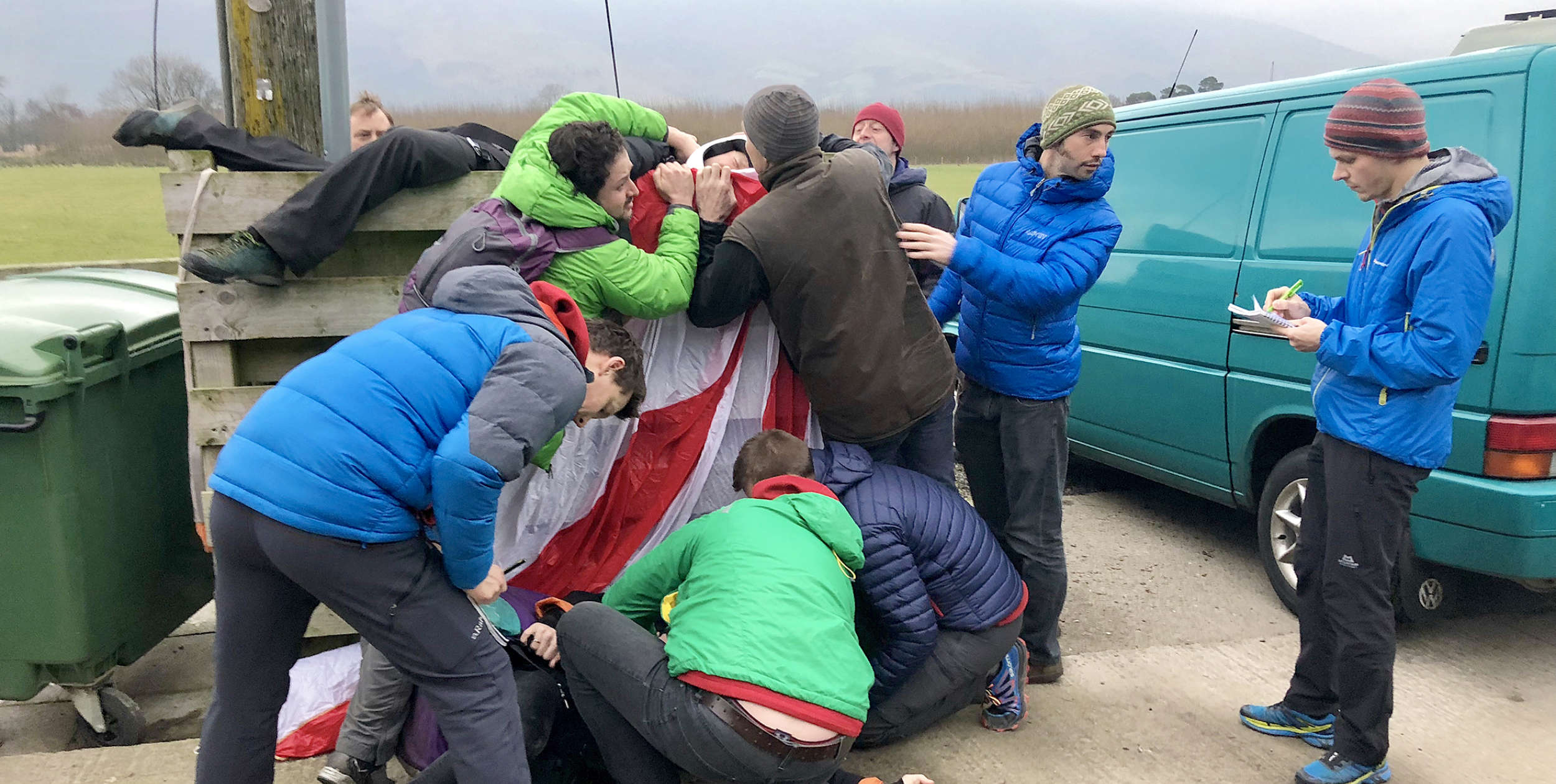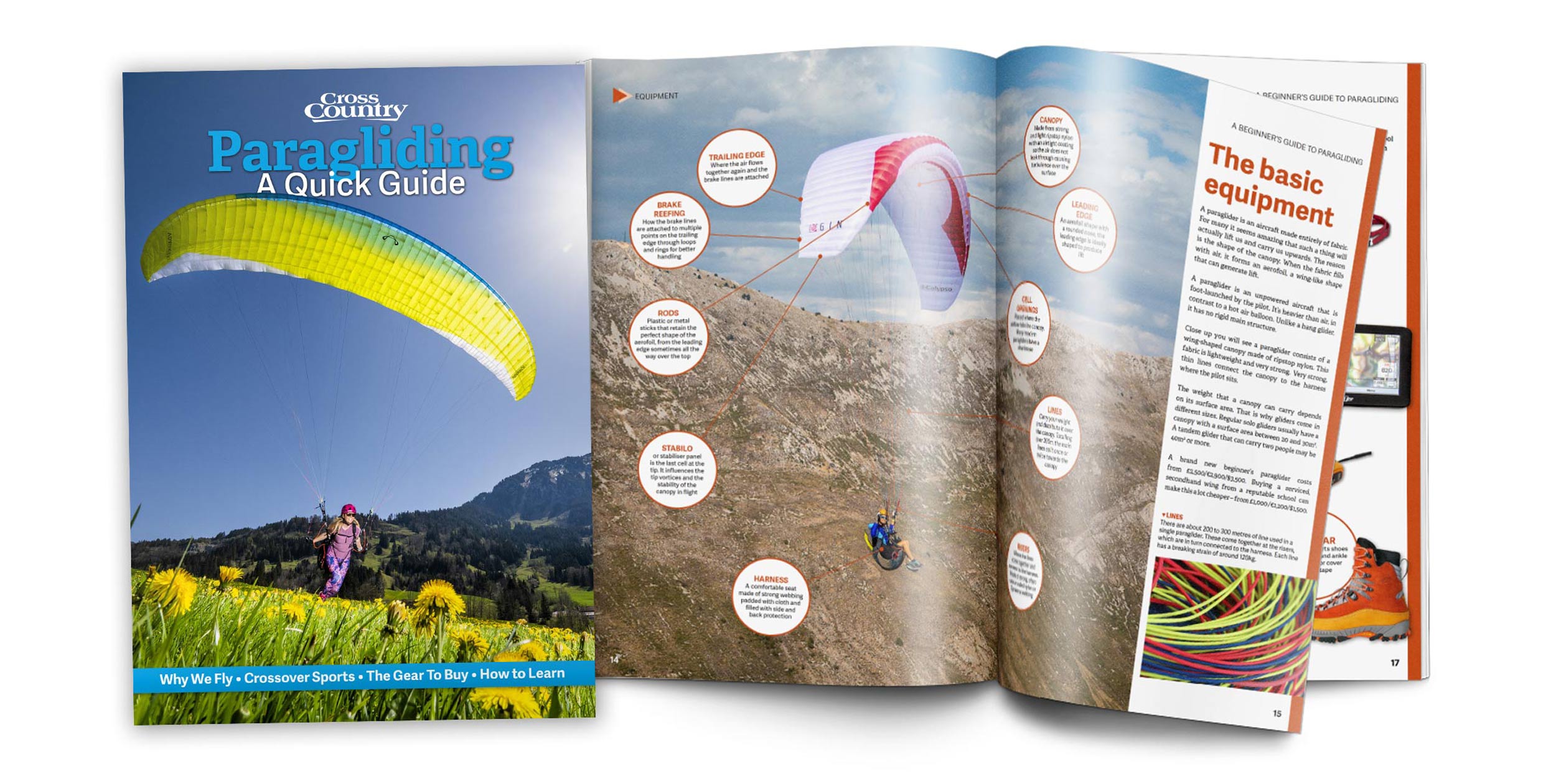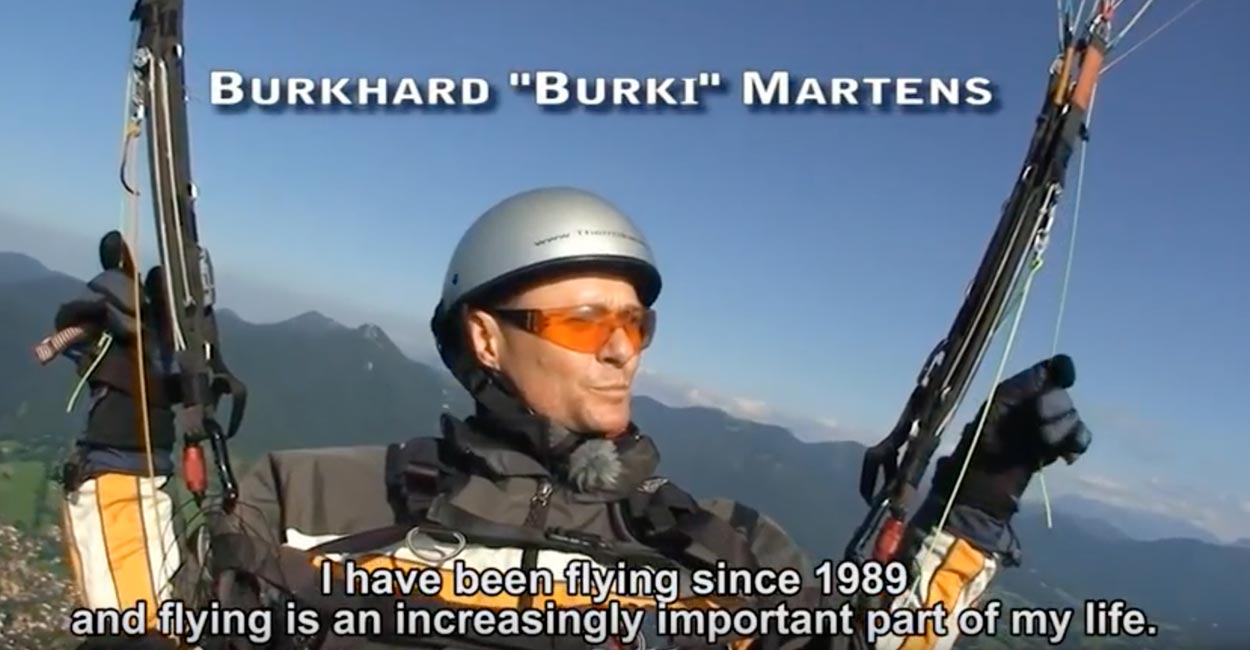‘Think positive, think up.’ Paragliding dreams by Advance
An essential guide to the golden rules of XC flying, by Patrick Laverty. First published in Cross Country magazine in 2001
Cross country hang gliding is a vast subject, and few pilots seem to write to pass on their knowledge to others. Perhaps they’re afraid of being laughed at because there are so many possible variations, but here I put my head above the parapet in an attempt to explain my own technique. Gliders and meteorology are beyond the scope of this article Im just talking about the flying technique which serves me well on my local Welsh ridges.
Look in the mirror
Assuming you want to fly XC in the first place and you are consistently failing, try looking in a mirror and admitting where the problem lies, i.e. entirely in your own head. The key is attitude and confi-dence. When you are nervous it is amazing how many perfectly valid reasons you can dream up for holding back. At one stage in my career I found refuge in excuses for a couple of years, but eventually had to face up to the challenge as I did WANT to fly XC.
If your confidence is low, start eliminating all potential excuses. Be well prepared before going to the hill:
- Personal items: wallet and mobile phone in your flying kit
- Car prepared: money, petrol and road-maps on board. Also, most important: keys in the car if youre organising a shared retrieve.
- Navigational items: good XC map, pen, and maybe, GPS. You should be able to navigate without a GPS spend time studying your map on those winter evenings. I carry a felt-tip pen tied to my map holder to dot my observed positions. This is a big help in lumpy conditions. Join the dots and you have got your track. You will know which town or village is next and whether you need to start tracking cross-wind to avoid air-space. Essential on long flights.
- Comfort and warmth: dress as if you will spend hours at cloud base, even on hot days. Warm clothes and gloves. Does your helmet tip forward into your eyes? Will your balaclava restrict vision? Does your harness pinch anywhere? Eliminate any irritants, because when you are cold, apprehensive and full of adrenaline at cloud base they will become the focus for negative thinking which will put you on the ground in no time.
- Equipment: good batteries in your vario and GPS? Hitching sign. Mine is a folded card with GLIDER PILOT. LIFT PLEASE? works everytime.
- Bladder: empty it before take off. The damp and cold at cloudbase reaches the bladder very quickly.
- Drink: carry a Camelbak, or at least a carton of juice. Dehydration causes tiredness and destroys concentration.
- Communication: Arrange a phone-in time with your mates before take off.
Just go
Dont take your lead from others unless you want to end up sitting on the hill discussing how useless the conditions are. Many pilots develop such an affinity for their mother flying site that cant leave its security and head off into the unknown. This can be a huge psychological barrier but it can be broken down by repeated short hops over the back. Everybody has to make the short hops first, and the sooner they are out of the way the better. Dont expect 50km on your first XC. Plan for 10km and then your confidence will not be dented.
Now, with all the preparations done, you should be cruising up and down your home site like a hungry shark looking for escape. The first thing to learn is to start operating on your own dont follow others around the sky. By all means use them as thermal indicators and take advan-tage if they find lift within reach, but if you chase others, often you get there just in time for the sink.
Independent thinking is called for on the ground as well as in the air. I have noticed that many pilots will spend the majority of a flyable day sitting on the hill. If you are apprehensive then it is very com-forting to join a group of like-minded individuals and stay put on terra firma. Unfortunately, lethargy and negative thinking thrive in this environment.
There is usually some part of the day when you can get away and it is best to be waiting for it, preferably in the air. If you just do the odd five-minute hop, you will be lucky to meet a decent thermal. If you fly for a few hours you will be unlucky not to.
Make your own luck!
Hunting for thermals out in front of the ridge is usually a waste of time. But fairly poor thermals get a nice kick-off from the ridge and often really lift off just behind it. So be prepared to thermal back, even when low, especially on a good flat-topped site. You will be amazed how often a scrappy broken thermal becomes bigger, smoother and better-formed behind take off.
To follow your thermal, keep your glider in steady smooth turns and dont let it tip you out. You may alter the radius to incorporate better areas of lift, but still keep your steady circle going. Some pilots develop a tendency when thermalling on a ridge to throw a quick 360, straighten for a while into wind, then another 360 etc. Do not do it! This leads out of the front of the thermal.
Get used to banking your glider over and leaving it there. This steady thermalling shows you the thermal drift and allows others to join in, thus marking out the limits of the thermal. Low down, thermals are rough and try their best to boot you out. Grit your teeth and fight them and at about 1500 ft (450m) you ought to be rewarded with a smoother, more pleasant climb. The better they are the harder they fight, low down. Incidentally, dont forget to turn the same way as the first person in the thermal.
If you are climbing at a steady 2 m/s up on average, you are probably heading for cloud base. Thermals often have lots of little cores with less lift, or even sink between them and your circling may be like a roller-coaster ride. Keep it going and you may be rewarded when the cores get together to give one nice smooth area of lift. If the lift starts to die off, open your turn out much wider and often youll find another area of lift nearby. On days of moderate wind you should be able to thermal to cloud base and still make it back to mother ridge if you wish.
But why go back? There you are in nice smooth lift which is surrounded by big sink. Straighten up even for a little while to decide and all your valuable height will disappear. So keep the monotonous circles go-ing, calm down and try to relax. When experi-enced XC pilots depart from a hill they will often still be turning the same steady way 20 minutes later when they reach cloudbase. Do not rush about like a headless chicken. Dont worry about out-landing and remember that it may be harder to fly back to the ridge than to keep on going.
Have patience
On nearing cloud base in active lift, dont go racing off downwind because there will be equally active sink. If there is wind, your thermal is drifting and so are you. It wont feel as if you are making much progress, because of the height you are at, but you will be covering the miles. So work a drifting thermal or cloud until it dies then head for the next likely looking one.
As you climb to cloudbase, keep an eye on the cloud itself. In the old days we flew as close to cloud as possible! If it was very black and nasty looking, we knew we had to avoid being sucked into it, so we would head towards the sunny side. We knew that the lift would be weaker at the edges and occasionally we could climb up the side, turning half in clear air and half in cloud. This was not as risky as it sounds because it was obvious where the sun was and the lift was usually very smooth. The sight of your glory reflected on the side of the cloud is wonderful and emerging from the grey into clear air can be one of the great joys of flying.
Another way of dealing with vigorous clouds is to fly out into the sink, turn around tightly and back into lift, in a stretched 360. The transition from lift to sink at altitude is usually smooth. If your cloud is joined to another in the direction you want to go, try feeling your way along under it but do not fly past the end. Rather, sit under the last bit and try to spot the cloud marking your next thermal downwind.
Close to cloud base it can be difficult to see the development downwind as there may be bits of cloud hanging down obscuring the view. Cloud shadows on the ground are good indicators, but remember to allow for the angle of the sun. While all this is going on, your own cloud will be getting less active. You may be able to spot its shadow on the ground getting thinner and breaking up. If it is a day which is over-developing and the clouds are not decaying, then dont fly under large dark masses of cloud. You will not find lift. Go to wispy straggly bits hanging down near the edges and search under them.
The next cloud
By the time you have milked your first thermal dry you should be able to pick the next part of route. This will not necessarily be straight downwind. You may do better to go crosswind to an active cloud the best ones are dark underneath and look like milky cauliflower on top. Dont be put off by a sky which does not look classic, as some amazing-looking days are useless and others, with hardly a wisp in the sky, are super because more sun can get to the ground.
When flying XC, the clouds are our main guide; ground thermal sources and ridges are only of interest when getting low. Avoid flying into large blue areas if possible. Often, when you are flying out of high ground into lower flat land, you will find large blue holes where descending air suppresses thermals. These can be hard to cross. It is often worth deviating to keep over high ground as it works better than flat land or valley bot-toms. To improve your chances of connecting with your next cloud, try to fly under it from directly upwind. If you are forced to approach from the side, make allowances for the fact that the thermal is probably leaning downwind.
Gliding efficiently
When travelling between clouds, fly at maximum-glide speed, but if there is no cloud to aim for, use minimum-sink, as you will cover more ground and, therefore, more possible thermal sources. If in sink, speed up. When gliding to another cloud, do not be so determined to reach it that you ignore little blobs of turbulence you may meet while in apparently clear air. Often you will work such a little patch of lift on the way to your next cloud which develops into an even better cloud. Lovely! Also, you catch it at the start and not halfway through, like the one you were originally aiming for.
Remember the rule: never leave lift! Be-tween thermals, get your head down level with your shoulders and your feet up towards the keel to reduce drag. Stay absolutely still and do not move your body around. Try not to tense up or stuff your toes into the bottom of your harness when thermalling or gliding. It just wastes valuable energy.
Between thermals watch your vario. If the sink starts to decrease or goes to zero, then do a large smooth 360. If you do not connect, elongate your 360 downwind. Hang on to a zero; quite often it will lift off and develop into an up. If not, you are still travelling. Even a 0.5 m/s thermal is worth a few 360s to see if a core is lurking nearby.
When you start getting below 2000 ft (650m) agl, start looking for thermal sources or soarable ridges. Thermals, low down, will probably be small and very vigorous. They do not want you aboard, so you will have to fight them. Little words of encouragement like “Come on you b****** GET ME UP”, repeated, seem to work well. It is amazing how will hang you on to lift during an XC which you would ignore while ridge soaring.
I have connected insignificant thermals at a few hundred feet, drifted towards a ridge, climbed up the face, floated over the back very low, only for the thermal to suddenly lift off to cloudbase. Vast numbers of per-fectly good XC thermals flow past ridge-soaring pilots who are all waiting for the big one to get them up and away. However, desperate XC fliers will work anything!
If you are getting low and there are no soarable ridges available, you should be heading for a land-ing area. By all means make detours to take in likely thermal sources, raised land masses, lee-side blast furnaces and so on. Even at this late stage do not give up, think positive. If you accept that you are landing in a certain field a mile away, you will. The little bumps you reject as you fly straight on your way there could be that late evening thermal which gets you back to cloud base.
Landing out
At all times during your flight a safe landing area must be within reach.
If it is windy and you are flying over deep narrow valleys, land on a flat hilltop. Gentle up-slope landings are easier than flat fields. Land beside civilisation, such as a farm house where you will find a telephone and maybe even a cup of tea. Give very precise instructions on your position and your intentions when you phone in. Now sit back, watch the sky upwind and pray you dont have to watch a string of your mates flying past overhead!
Remember:
- Dont leave lift.
- The tortoise and the hare: be slow and patient dont just race off downwind.
- Never, ever, think down. A lot of time and money can go into planning and dreaming XCs. Do not ruin it by negative thoughts which will have you making your landing flare in no time.
Updated in January 2011
• Got news? Send it to us at news@xccontent.local
Subscribe to the world’s favourite hang gliding and paragliding magazine







